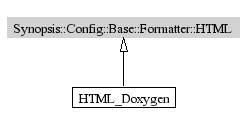
Config object for HTML Formatter. This is the most complicated config object, because the HTML formatter is itself very modular and flexible, allowing the user to customise output at many levels. All this flexibility comes at a price however - but if you read this (and send feedback to the Synopsis developers) then it should get easier.
| name | The name of the module, ie: 'HTML' |
| stylesheet | The filename of the stylesheet file linked to by all generated pages. |
| stylesheet_file | Specifies a file which is read and written over the stylesheet file in the output directory. It is only copied if it has a newer timestamp than the existing stylesheet file. The default is the file html.css installed in Synopsis' share directory. |
| pages | Lists the names of page modules to load and process in order. Each module generates a different type of output, and some register names to be shown as a link at the top of every page. For example, ScopePages generates the pages for Classes, Modules, etc. ModuleIndexer creates the index pages for all the modules that usually go in the bottom-left frame. FramesIndex creates the index.html with the frames. The default is ['ScopePages', 'ModuleListingJS', 'ModuleIndexer', 'FileTreeJS', 'InheritanceTree', 'InheritanceGraph', 'NameIndex', 'FramesIndex'] |
| comment_formatters | Lists the formatters to be applied to all comments. The default is ['javadoc', 'section']. Javadoc formats javadoc-style @tags. Section splits blank lines into paragraph breaks. The quotehtml formatter quotes any html characters such as angle brackets and ampersands, such as comments that mention C++ templates. This also has the effect of disabling any HTML in the comments, and so is off by default. |
| sorter | Specifies the Sorter to be used to sort declarations on Scope Pages. You may set this to override the default sorting, for example using ('Synopsis.Formatter.HTML.doxygen', 'DOScopeSorter') |
| structs_as_classes | A boolean value which if set causes structs to be listed as classes in the output. The default is 0 (false). |
| tree_formatter | Specifies which tree formatter to use. There is a default package of 'Synopsis.Formatter.HTML' and the default value is 'TreeFormatter.TreeFormatter' |
| file_layout | Specifies the file layout to use. This must be a class that implements the FileLayout interface defined in the HTML.FileLayout module. |
| output_dir | Specifies the base output directory for generated files. May be an absolute or relative path, but absolute will probably work better in larger projects with TOC references. If this option is not set, the -o argument must be used when running Synopsis. Simple example: 'output/html' |
| Classes Summary: | |
| FileSource This is the config object for the FileSource module. [Source] | |
| FileTree Config object for the FileTree module. [Source] | |
| ScopePages Config for ScopePages module. [Source] | |
| InheritanceGraph Config for InheritanceGraph module. [Source] | |
| ModuleListing Config for ModuleListing module. [Source] | |
| Operations Summary: | |
| __init__(self, argv) Initialise HTML config object. [Source] | |
| Operation Details: |
Initialise HTML config object. If there is a verbose argument, then the verbose attribute is set to true, causing various verbose information to be printed out.